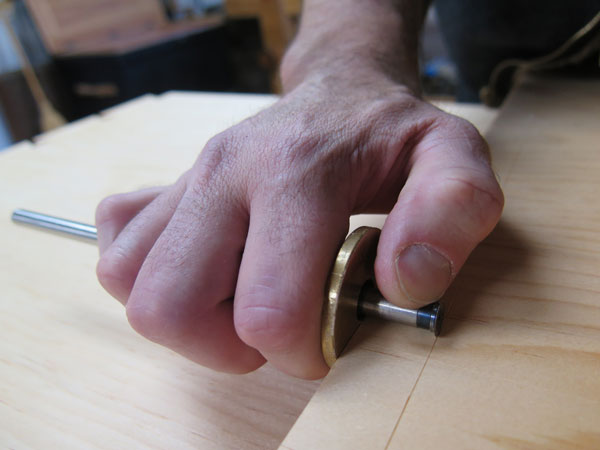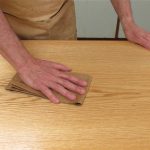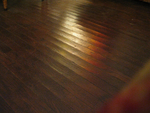We may receive a commission when you use our affiliate links. However, this does not impact our recommendations.
I cut my first dovetail in 1993 and that was also the first day I learned to use a marking gauge. The instructor didn’t tell me how to use it, so I set it and worked things out for myself. I ended up marking my baselines by pulling the gauge toward me.
And I’ve never done it any other way.
The funny thing is that this year I’ve been editing a lot of 20th-century writing on handwork from 1937 to 1967. And the advice from every author is universal: Push the marking gauge away from you to make your line. Don’t pull it toward you.
They don’t really say why. Though they do show you how to set up the pin in the gauge so that it works only when you push the gauge.
I’m at odds with this advice. I’m going to investigate it some more, but I don’t think I’m going to blindly switch to pushing my marking gauges and cutting gauges.
— Christopher Schwarz
Here are some supplies and tools we find essential in our everyday work around the shop. We may receive a commission from sales referred by our links; however, we have carefully selected these products for their usefulness and quality.











Seems like the way it works is the way it works for you. Don’t be a slave to convention just because someone thinks you’re not doing it the way they do.
In 1979 (I had to think about that!) when I started studying woodwork at school, one of the first tools we were taught was the making gauge. Old style wooden ones but with a thumb screw rather than a wedge (I’m not THAT old). Anyway, our very experienced (read 50+) instructor taught us to push the gauge … after dropping the point in at the far end to make a stop hole. He did, however, teach us that the gauge can be pulled if the grain is causing it to push away from the work. As a child, pushing the gauge certainly made it easier to keep the guide plate against the work, although that is obviously less of an issue Ruth adult hands.
As a side note, he also taught that it was poor craftsmanship to score a line across the pins or tails of dovetails – “a properly used gauge should be able to mark the back of every piece of waste while never leaving a mark which will be seen after the joint is cut” [paraphrased]
It sounds like this issue is similar to the issue with certain saws that can work either way:
-Coping saws and fret saws can work with the blade installed either way
-With sliding compound miter saws, the most common written advice says to push, but both my teacher and my personal experience say pull, because if you push, the saw blade wants to lift the wood.
I found out that for 40 years I have been pour from the wrong side of a rectangular can. I wonder how many others things I do are wrong .Somethings the obvious way it the the better way. Oh well, keeps me humble.
Jeff Miller taught me, and it’s in his excellent new book too, that pulling towards you gives better control because you loose control as your forearm arcs away from the body.
2 thoughts……1. To each his own! 2. If a righty is pulling then a lefty will be pushing assuming the gauge is set up the same.
While it’s usually the case that a technique used for years prior equates to something being refined and well thought out, there are exceptions.
The most obvious is “Starboard/Larboard vs. Starboard/Port”. The British navy still had “Larboard” on the books until 1844, even though it was obviously a bad and dangerous term!
Derek,
You will see that my pin position has been modified, to make it visible for starting and stopping, when pushed.
I do this for “tidy” dovetails, rather than marking a line right through.
I prefer my cheap modified gauge to even the most expensive, (most of the time!) They have a Clenton like pin mod.
Best wishes,
David
I have read your blog and try to understand. I also read all comments by others. I also use the marking gauge in both directions. I don’t have get any new idea or method to use marking gauge or cutting tool.
Yep, this is how I do it as well. If it ain’t broke don’t fix it.
I’ve got my marking gauge set up to mark, or cut in both directions. I often push at the far end as it’s easier to keep a solid reference on the end of the board. Most of the movement, however, is pulled towards me. The only thing to this is that if you push the gauge you have to change your hand position. It’s possible that the more comfortable pulling position may also tend to twist the gauge off your line. I should also clarify that my most common gauge is the old Stanley No. 61, not a wheel gauge.
Chris, I used to use a marking gauge pushing forward, a gauge with a pin. I was shown this by my grandfather and never thought about it, just copied what I was shown. I changed later to the marking gauge shown above and used it by pushing and the cutter came loose after a dozen or so uses. I tightened it and then it came loose again.
I watched a video of you or someone else using the gauge and they pulled the gauge towards themselves. The design of this gauge needs to be pulled as you are tightening the cutter as you pull towards yourself.
This is for right handed, if you are a lefty I would push the gauge.
Japanese marking knives have a directional knife to do the marking, and so are usually set up to be pulled using the right hand. Traditionally these marking knives also cut the thin assembly pieces (kumiko) in Shoji frames, and the softwoods in small pieces worked better if the blade was pulled rather than pushed; pushing, just like pushing a thin sawblade, could cause the wood to flex or the blade to stray.
This reminds me of two things.
First my Grandfather always told me there is always more than one way to do any operation.
The second was a shop teacher said, “there is the right way, the wrong way and the way that works.
To each his own. I have always pulled it towards me, and it works.
I believe there’s more control when pulling tools towards you. I started looking at the grain direction of the piece I’m scribing and pulling the gauge in a direction that will make the grain pull the cutting wheel and force the fence against the edge; I alternate positions to always do a pull motion relative to the grain.
Chris, just checked David Charlesworth’s video on drawer making … he pushed his pin gauge AWAY from his body when scribing the baselines ..
Do the texts provide a reason for this?
Regards from Perth
Derek
Please take your thumb off the rod keep it behind the face plate of the marker; after all this isn’t the Stanley wooden scriber.
You are using a Japanese marking gauge. And you are editing writings of guys that used western marking gauges. So all is good.
This is fascinating…I just started using a marking gauge and it just “felt right” to pull it towards me. I will give this a shot to see if there is any noticeable difference in the quality/accuracy of my marks.
Thanks Chris!
I use the marking gauge in both directions – whichever feels the most comfortable at the time.
So you’ve been doing the same thing for 22 years, with reasonable success. Sounds like it works. And while it may not work for everyone, it can work for some. Elbow bending, dynamics, physics – it all plays in discovering what works for someone and not for someone else. Great to pass along experience that each of us have, and someone will discover why their technique hasn’t been working and fix their problem.
Phil Lowe always told us to push. It gives the scribes more control.
FR
As a left hander I had problems with my Glen-Drake marking wheel. When I pulled the gauge the wheel would start to loosen up. I wrote Glen about this issue and he suggested I do both, pull and push. Pull from the far end to about the middle and push from the near end to about the middle (overlapping of course). I have used that technique since then with great results. I have also not had an issue with the cutter coming loose (I did follow his advise to use a star washer under the cutter).
I use a marking gauge similar to the one shown in the photo and pull it with my right hand and push it with my left. Reversing things eventually causes the small screw holding the cutting wheel to loosen at the end of the gauge. I also pull a knife when marking. Seems like you should do things that work best for you.
I believe it is about the type of marking gauge and how each one works best. These new gauges with the roller feel and work better being pulled.
But also, he was the expert in the 20th century.
We have our own expert we like to follow. Might as well embrace the fact you set the new trend that become rules now.
And you make fart jokes……. so all is good!
One possible explanation is the position of the thumb relative to pulling or pushing a traditional marking guage.
In a push your thumb lock is acting in direction of movement and is pushing down into the wood.
In a pull movement your thumb lock is against the direction of movement and is pushing upwards so thumb is more passive.
I find that when I push the gauge away from my body I am less inclined to bear down.
I think this only has to do where you are standing relative to the line being drawn.
This is because you want to keep pressure on the fence against the board edge. If you stand so that the line is between you and the fence, then pressure on the fence against the edge is more easily maintained if you pull. But if the fence is between you and the line it is better to push.
My Dad taught me to pull the marking gauge towards me in about 1953, he was taught by his Father 40 years earlier who was taught by his Father 40 years before that. They were all professional woodworkers. This gives a date of about 1873 when professional joiners were pulling their gauges . My Dad told me that some amateurs pushed and it was because it was possible to cut a fingers if pulling so you had to be careful. He thought it was a misunderstanding of the safety advice to always cut away from you. He was also sure it was more accurate and natural to pull.
Instead of pushing the gauge, just start editing texts from after 1980 when every author describes pulling the gauge.
Why do I feel there should be some Spock with a goatee reference soon….
If you use a standard marking gauge with a pin in a bar, you can see the line as you score it if the pin is toward you. If you then pull the gauge, it runs the risk of digging into the work.
if like here the tumb is set over the pin the best way to see the line is to pull, but i think they used a different type of marking gauge with an off center grip.
As already mentioned, it seems like you’d have more control by pulling. “Pulling” is always converging on your centre; “pushing” can go any of a number of directions. Thus “pulling” seems like it’d be more stable.
If “pushing” was so good — why not with a spokeshave and drawknife?
I always pull my marking gauges. The workpiece is often braced against my (tensed) belly. Short pieces are just held in the hand.
re: “elbow swinging away” — My elbow tends to **already** be up, rather than down — much like revving a motorcycle — when I hold the marking gauge. But maybe I’m just holding it wrong. 🙂
–GG
I’ve felt it key that the gauge leave a mark the correct distance in, without following the grain. Never occurred to me that there was a right or wrong way to do this until I read Robert Wearing. Apparently as a rank beginner I ought to have my piece secured in a vise, among a myriad of other things.
I’m in the same boat as you Chris, and I plan to continue pulling the marking gauge towards myself, too. My rationale is similar to how I prefer to use a woodworking float that cuts on the pull stroke. I find I have better fine control on the pull vs. the push stroke.
Cheers
Lee Laird
I use a marking gauge that has a screw holding the cutter on (tite-mark).
I use the gauge in whatever direction naturally tightens the screw, so that it will never loosen in use. If I’m holding a piece in my left hand, I pull the gauge toward me with my right hand and vice-versa.
I developed this habit after the screw loosened itself once in use.
Whenever I push my Tite-Mark away from me there is a tendency for the blade to unscrew. After this happened a few times I started making sure I was always pulling the gauge toward me. Older style marking gauges were just straight blades or pins, which would allow either push or pull. The Tite-Mark is a fantastic tool, but maybe this is one limitation?
I’ve read the same about always pushing a marking gauge in “old” English woodworking texts. To me the rational is:
A) You roll the gauge a bit forward (square beam design) and drag the corner of the beam while engaging the pin to get more support.
2) You can watch the pin mark your line and make sure you don’t drift or wander. Cross-grain, not so much of a problem. Long grain, this does help me.
iii) If you are working on a benchtop, then by pushing, you can push the whole of your work against a stop while making the mark.
And frequently the next few sentences describe how to file the pin into a pseudo-blade and get a bit cleaner line.
I think it was either Jennie Alexander or Peter Follensbee that made an offhand comment “you can pull or push a marking gauge but always push it” in something they wrote.
I’d have to agree with bstjohn. It would think that as you pulled it toward yourself, your elbow would automatically swing away to clear your body and potentially pull your hand way in an arc pattern. If you start with your hand and elbow in close to you and push it away the guage fence will be pushed into the piece the entire distance. I wouldn’t have thought it made any difference except I read Jeff Millers book on the subject of body positioning and woodworking. Give him a call.
Three reasons that I know about when using a traditional spurred marking gauge and holding the wood to be gauged propped at an angle between your slightly open bench vice and your supporting hand:
1. Safety – if you pull the gauge it can cause puncture wounds in your supporting hand, fingers or thumb at the end of your marking pull if you over run. (No antibiotics in the 1930s).
2. You can’t see the line you are marking if you pull so it is harder to see if you have produced a clean line parallel to the edge.
3. It is easier to roll your wrist away from your body to angle the spur into an effective marking tool and maintain efficient three directional control and pressure on the stock and stem.
The modern wheeled marking gauge can be pushed or pulled but do be careful with overrunning and keeping your hands out of the line of the cut.
I’d guess it’s to do with the bending action of the arm/elbow, which could tend to pull the hand away from the work? But this is easily accounted for and dealt with, if one pays attention. Just an off-the-cuff explanation…